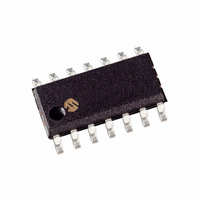HCS473T/SL Microchip Technology, HCS473T/SL Datasheet - Page 13

HCS473T/SL
Manufacturer Part Number
HCS473T/SL
Description
IC KEELOQ 3AXIS TRANSCODR 14SOIC
Manufacturer
Microchip Technology
Series
KEELOQ®r
Type
Code Hopping Encoder and Transponderr
Specifications of HCS473T/SL
Applications
Access Control Systems
Mounting Type
Surface Mount
Package / Case
14-SOIC (3.9mm Width), 14-SOL
Lead Free Status / RoHS Status
Lead free / RoHS Compliant
3.0
HCS473 operation depends on how the device is acti-
vated. The device exits Low-power mode either when a
switch input is pulled high or when a signal is detected
on an LC antenna input pin. Once activated, the device
determines the source of the activation and enters
Encoder mode or Transponder mode.
A button input activation places the device into Encoder
mode. A signal detected on the transponder input
places the device into Transponder mode. Encoder
mode has priority over Transponder mode such that
communication on the transponder input would be
ignored or perhaps interrupted if it occurred simulta-
neously to a button activation; ignored until the button
input is released.
3.1
3.1.1
3.1.1.1
The main way to enter Encoder mode is when the
wake-up circuit detects a button input activation; button
input transition from GND to V
logic wakes and delays a nominal switch debounce
time (T
ton input states, cumulatively called the button status,
determine whether the HCS473 transmits a code hop-
ping or seed transmission.
The transmission begins a time T
consists of a stream of code words transmitted as long
as the switch input is held high or until a selectable
TSEL timeout occurs (see Section 3.1.4.16 for TSEL
options). A timeout returns the device to Low-power
mode, protecting the battery in case a button is stuck.
Additional button activations during a transmission will
immediately reset the HCS473, perhaps leaving the
current code word incomplete. The device will start a
new transmission which includes the updated button
status value.
Buttons removed during a transmission will have no
effect unless no buttons remain activated. If no button
activations remain, the minimum number of complete
code words will be completed (see Section 3.1.4.15 for
MTX options) and the device will return to Low Power
mode.
3.1.1.2
A second way to enter Encoder mode is if the proximity
activation option (PXMA) is enabled and the wake-up
circuit detects a wake-up sequence on an LC antenna
input pin. This form of activation is called Proximity
Activation as a code hopping transmission would be ini-
tiated when the device was proximate to a LF field.
2002 Microchip Technology Inc.
DB
DEVICE OPERATION
Encoder mode
) prior to sampling the button inputs. The but-
ENCODER ACTIVATION
Button Activation
Proximity Activation
DD
. The HCS473 control
PU
after activation. It
Preliminary
3.1.2
The HCS473 transmits a 69-bit code word in response
to a button activation or proximity activation, Figure 3-
1. The code word content varies with the two unique
transmission types; Hopping or Seed.
3.1.2.1
Hopping code words are those transmitted during nor-
mal operation. Each Hopping code word contains a
preamble, header, 32 bits of encrypted data and up to
37 bits of fixed value data followed by a guard period
before another code word begins.
• The 32 bits of Encrypted Data include button sta-
• The 37 bits of Fixed Code Data include queue
3.1.2.2
Seed code words are required when the system imple-
ments secure key generation. Seed transmissions are
activated when the button inputs match the value spec-
ified by the seed button code configuration option
(SDBT), Section 3.1.4.9.
Each Seed code word contains a preamble, header
and up to 69 bits of fixed data followed by a guard
period before another code word begins.
• The 69 bits of Fixed Code Data include queue
tus bits, discrimination bits and the synchroniza-
tion counter value. The inclusion/omission of
overflow bits and size of both synchronization
counter and discrimination bit fields vary with the
CNTSEL option, Figure 3-2 and Section 3.1.4.5.
bits (if enabled), CRC bits, low voltage status and
serial number. The inclusion/omission of button
status and size of the serial number field vary with
the XSER option, Figure 3-2 and Section 3.1.4.3.
bits (if enabled), CRC bits, low voltage status, but-
ton status and the 60-bit seed value, Figure 3-2.
Note:
For additional information on K
ory and implementation, please refer to the
K
(TB003).
TRANSMITTED CODE WORD
EE
Hopping Code Word
Seed Code Word
L
OQ
introductory
.
HCS473
DS40035C-page 11
Technical
EE
L
OQ
Brief
the-














